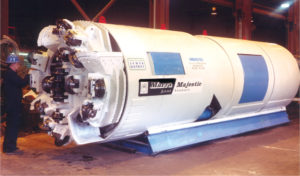![65 Years of Innovation and Experience [default]](https://www.robbinstbm.com/wp-content/uploads/2017/04/Side-Bar-Blue-Blocks_70-Years.jpg)
A Solution for Every Condition: Search our Project Database
Project Map
FEATURED PRODUCT: CROSSOVER MACHINES
Our History
A Legacy of Innovation
Information 24/7
News & Media
Insights in the Industry:
Read the Robbins Blog
The Cleveland Heights Interceptor Project is a sewer system improvement project located in the Heights/Hilltop area of Cleveland. The project is one of hundreds projects mandated by the USA Environmental Protection Agency in the wake of the Clean Water Act which required communities to improved the quality of America’s river and lake water. (For more information on the Clean Water Act and its effects, see www.epa.gov/r5water/cwa.htm).
 During the torrential rains of spring and summer in the Cleveland area, the water flow overcame the existing sewer system resulting in flooding and the discharge of untreated water into Lake Erie. Larger-diameter pipelines were proposed to help reduce the basement flooding and sewage overflow problems which were common in the crowded urban area.
During the torrential rains of spring and summer in the Cleveland area, the water flow overcame the existing sewer system resulting in flooding and the discharge of untreated water into Lake Erie. Larger-diameter pipelines were proposed to help reduce the basement flooding and sewage overflow problems which were common in the crowded urban area.
The TBM passed mostly through gray Berea sandstone that is fine to medium grained and significantly fractured in discrete zones. The rock has moderate to high abrasiveness as well as a potential for gas and water inflows from fissures and joints.
Robbins designed the 2.2 m (7.2 ft) diameter TBM to bore through fractured rock with potentials for water inflow. The TBM included a variable speed, hydraulic cutterhead drive and a high-capacity asymmetric main bearing. The machine also included roof and probe drills for rock support and pre-excavation ground investigations respectively. The TBM featured 12 inch (305 mm) cutters that could generate a maximum thrust of 4,472 kN (1,006,000 lb). Maximum cutterhead torque was 194,172 N-m (146,000 lb-ft). The 60-ton, gantry-style back-up system was designed to run efficiently with muck cars at maximum capacity.
The TBM began boring in July 1998. It experienced few problems and achieved impressive daily advance rates. Between the months of September and December 1998 the machine averaged 42 m (138 ft) per day and achieved a best day of 55 m (182 ft) bored. The machine finished in December 1998 with a monthly average of 442 m (1450 ft). Crews worked in 5-day work weeks with 2 shifts per day and the machine averaged 21 m (69 ft) per shift.

 Close
Close